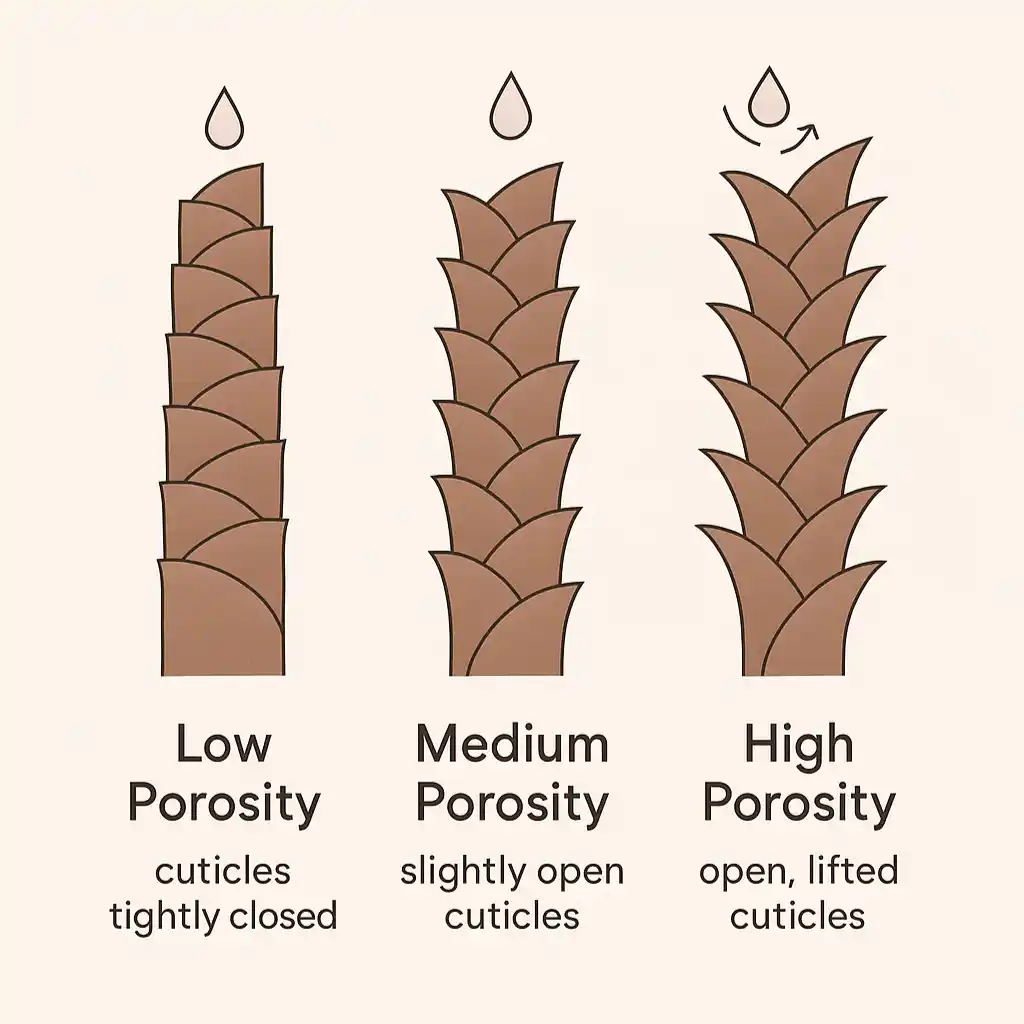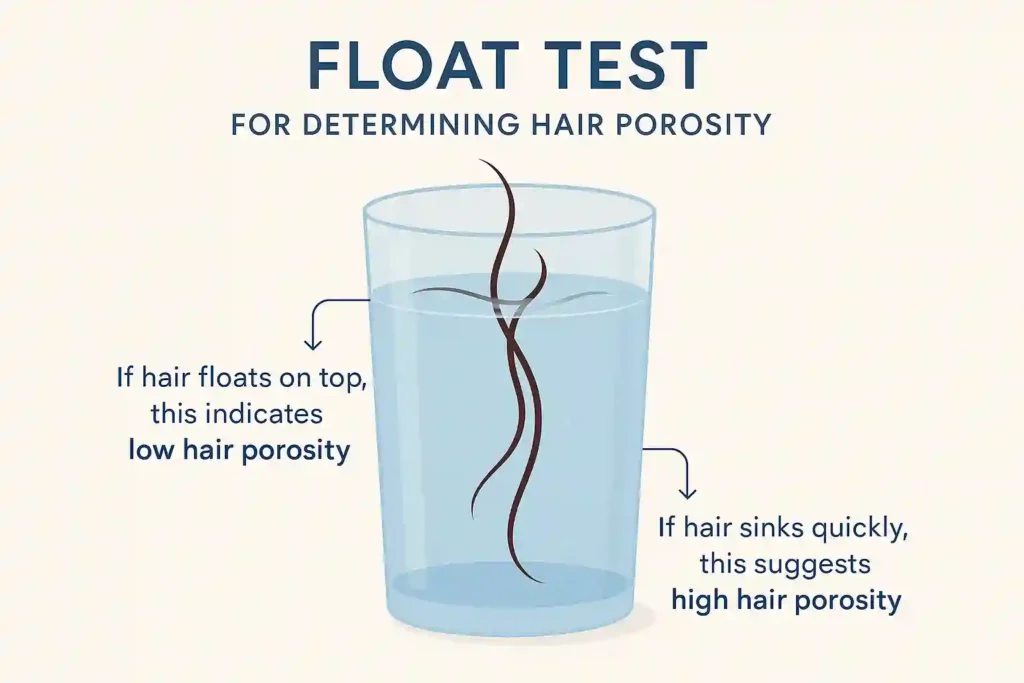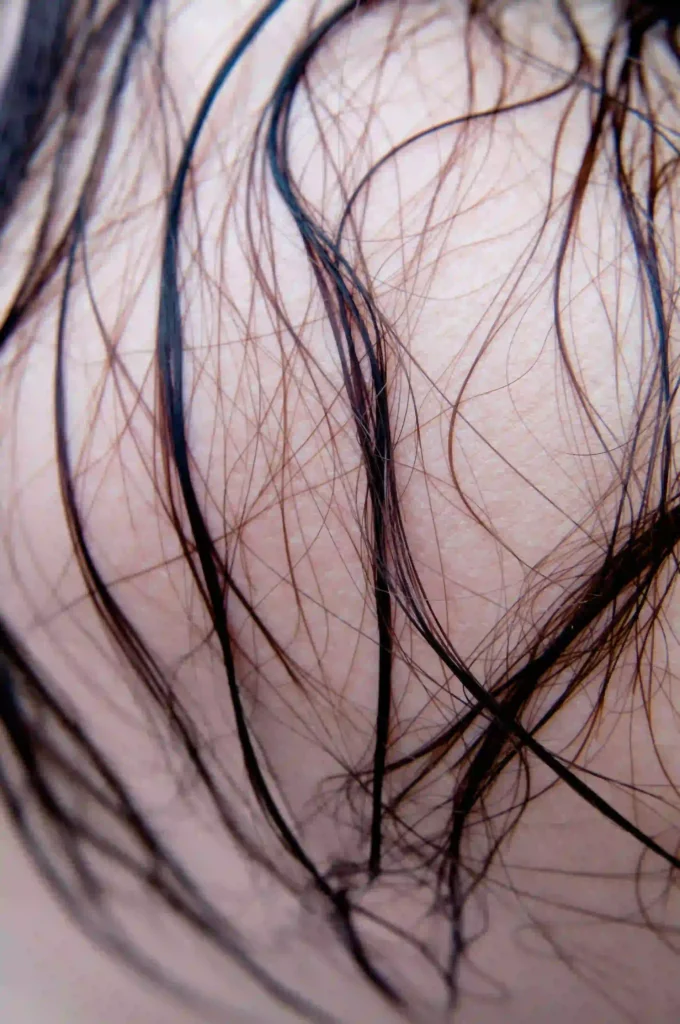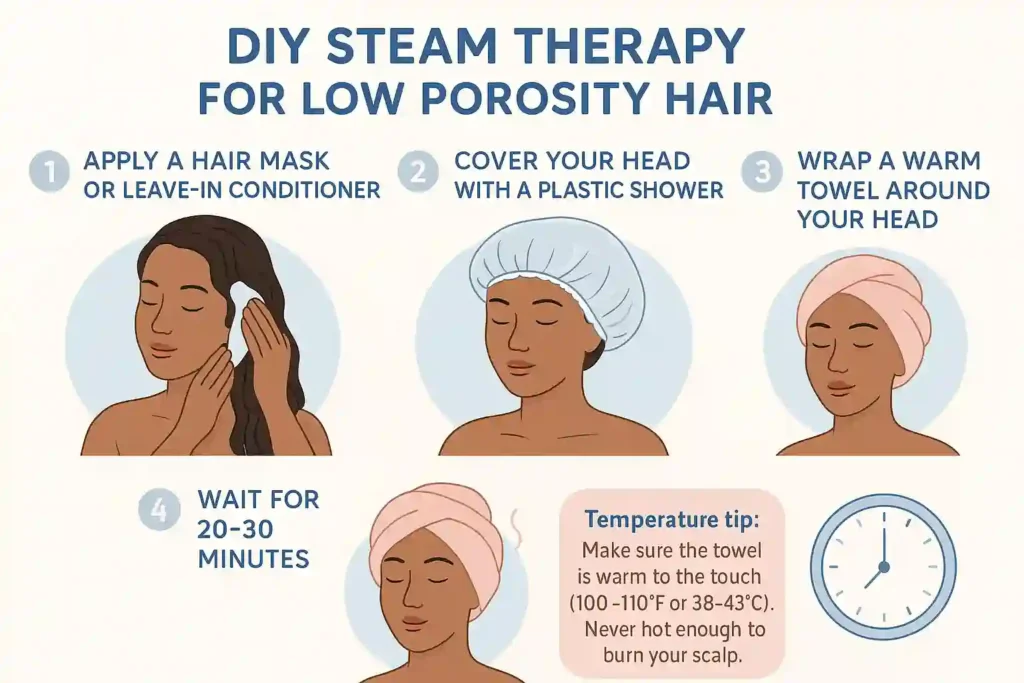
Ever feel like your hair just won’t soak up moisture, no matter what product you use? You might have low porosity hair, and trust me, it’s more common than you think.
So, what is low porosity hair? In simple terms, it means your hair cuticles are tightly packed and flat, almost like shingles on a roof.
This makes it hard for moisture, oils, and products to get inside the hair shaft. Think of your strands like a raincoat, water tends to sit on top rather than soak in.
Because of this, the wrong products can just sit on your hair, causing buildup, dryness, or frizz.
That’s why choosing the right low porosity hair products matters so much, whether it’s a lightweight leave in conditioner for low porosity hair, a gentle shampoo for low porosity hair, or light oils like jojoba oil for low porosity hair.
Now, you might be wondering: what does low porosity hair mean for your routine? It simply means your hair needs a bit of coaxing, like steam, the right products, and a little patience.
We’ll cover all of that ahead. But first, let’s help you define low porosity hair and find out how to know if you have low porosity hair.
1. How to Know If You Have Low Porosity Hair (3 Easy Tests at Home)
Before you invest in low porosity hair products, you need to know one thing: Do you actually have low porosity hair?
Let’s break it down simply. Low porosity hair means your hair’s outer layer (called the cuticle) is tightly sealed.
This makes it harder for water and products to enter. So, even if you’re using the best conditioner for low porosity hair, it might not absorb properly if you’re not applying it the right way.
Here are 3 easy ways to test your hair porosity at home:
1. The Float Test
Take a few clean, dry strands of your hair and drop them into a glass of water.
Wait about 5 minutes.
- If your hair floats on top, that’s a sign of low hair porosity.
- If it sinks quickly, your hair might be high porosity.

a. The Spray Test
Spray a small section of your hair with water.
If the water beads up and just sits there for more than 5 seconds, your hair likely has low porosity. High porosity hair absorbs water almost instantly.
b. The Slip & Shine Test
Run your fingers down a clean strand of hair.
Low porosity hair often feels smooth but may appear dull.
It tends to resist oils and moisture at first, which is why using the right hair oil for low porosity hair or jojoba oil for low porosity hair is key.
Now that you know how to define low porosity hair and identify it, you’re ready to find the right hair care for low porosity hair, including choosing the best shampoo and conditioner for low porosity hair that actually work with your cuticle structure, not against it.
Stay tuned, we’re diving into that next!
2. Frustrated With Dry, Dull Hair? These Are the Real Signs of Low Porosity Hair

If your hair takes forever to dry, doesn’t absorb moisture easily, or products just sit on top of it… you’re likely dealing with low porosity hair.
But what does low porosity hair mean, exactly? It means your hair cuticles are tightly packed, like overlapping roof shingles.
This makes it hard for water and hair products for low porosity hair to get in. So even though you’re moisturizing, your strands might still feel dry.
Here are some common signs of low porosity hair:
- Products feel like they “sit” on your hair instead of absorbing
- Long drying times, even hours after washing
- Hair feels dry or coated, especially near the roots
- Difficulty absorbing hair oil for low porosity hair or even water
One major challenge? Product buildup. When heavy creams or oils don’t absorb, they layer up on the surface.
Over time, this blocks moisture even more. That’s why using a clarifying shampoo for low porosity hair once a week (or bi-weekly) can make a huge difference.
How to avoid product buildup in low porosity hair?
Use lightweight low porosity hair products, avoid heavy waxes or butters, and clarify regularly.
Also, stick to light oils for low porosity hair like argan or jojoba.
Lastly, let’s bust the myth: low porosity isn’t “bad” hair. It just needs the right approach and the right low porosity hair care routine.
3. Low Porosity vs High Porosity Hair: Know the Difference
When it comes to healthy hair, understanding your porosity is just as important as knowing your curl type.
If you’ve been wondering about high vs low porosity hair, or confused by terms like low vs high porosity hair, don’t worry, you’re not alone.
Let’s break it down simply.
Low porosity hair has a tightly sealed cuticle layer. That means water and products absorb slowly.
On the other hand, high porosity hair has raised or damaged cuticles, so moisture goes in quickly, but also escapes fast. This difference affects everything from how your hair dries to which products actually work for you.
| Feature | Low Porosity Hair | High Porosity Hair |
| Cuticle Structure | Tightly closed | Open or damaged |
| Water Absorption | Slow | Fast |
| Drying Time | Long | Quick |
| Product Buildup Risk | High | Lower |
| Shine Level | Naturally shiny | Often dull or frizzy |
| Ideal Oils | Light oils like jojoba oil for low porosity hair | Heavier oils like castor |
Knowing the difference between high porosity hair vs low helps you build a smarter routine. For example, low porosity hair products should be lightweight and buildup-free, while high porosity hair may need richer, more sealing options.
Once you know where you stand on the low vs high porosity hair scale, picking the right hair care for low porosity hair (or high) becomes much simpler.
4. The Perfect Low Porosity Hair Routine: What to Use, When, and How Often
When caring for low porosity hair, it’s not just about what you use, it’s about how and when you use it.
Since low porosity strands resist moisture, you need a smart, consistent routine that gently opens the cuticles and layers in hydration without buildup.
So, how often should I deep condition low porosity hair?
For most, once every 7 to 10 days is ideal. Using a deep conditioner for low porosity hair with light heat or steam helps nutrients absorb better.
Morning Routine
- Start with a mist of warm water to soften the hair.
- Apply a lightweight leave in conditioner for low porosity hair (avoid thick creams).
- Seal with light oils for low porosity hair like argan or jojoba oil for low porosity hair.
Optional: Use a warm towel or steamer for a few minutes to boost product absorption.
Night Routine
- Gently detangle using fingers or a wide-tooth comb.
- Refresh with a hydrating spray or a small amount of hair oil for low porosity hair.
- Pineapple your curls or wear a satin bonnet to reduce friction.
Weekly Schedule
- Wash Day: Use a sulfate-free shampoo for low porosity hair
- Clarify (every 2 weeks): Remove buildup with a gentle clarifying shampoo for low porosity hair
- Deep Condition (weekly): Use heat or steam for better results
- Hair Mask (biweekly): Apply a light hair mask for low porosity hair
By sticking to this routine and choosing the right low porosity hair products, you’ll notice better moisture retention, less frizz, and healthier strands overall.
5. Best (and Worst) Ingredients for Low Porosity Hair: What to Use & What to Skip
When it comes to low porosity hair, choosing the right ingredients is everything. Your hair doesn’t absorb moisture easily, so you need lightweight, humectant-rich formulas that help open the cuticles gently and hydrate effectively.
So, what ingredients/products are good for low porosity hair? Let’s break it down.
Best Ingredients for Low Porosity Hair
Look for products that are water-based and contain light, nourishing ingredients like:
- Aloe vera – hydrates without buildup
- Honey – a natural humectant that draws in moisture
- Glycerin – helps attract water into the hair shaft
- Argan oil – lightweight and non-greasy
- Jojoba oil for low porosity hair – mimics natural scalp oils
- Coconut water – hydrates without weighing the hair down
These are commonly found in leave in conditioner for low porosity hair, deep conditioner for low porosity hair, and even hair mask for low porosity hair blends.
Watch Out For These Ingredients
What ingredients/products should be avoided for low porosity hair?
Be cautious with heavy, sealing agents like:
- Silicones – can block moisture when overused
- Thick butters (like shea butter) – may coat strands without penetrating
- Heavy waxes – cause buildup and repel water
- Strong proteins – may stiffen the hair and cause dryness
Unless your hair is severely damaged, high-protein products aren’t the best for low porosity hair care routines.
Quick Ingredient Focus Table
| Type | Use For Low Porosity? | Examples |
| Light Oils | Yes | Argan, Jojoba, Grapeseed |
| Heavy Butters/Waxes | No | Shea butter, Beeswax |
| Humectants | Yes | Glycerin, Aloe Vera, Honey |
| Proteins (Hydrolyzed) | Use sparingly | Silk protein, Keratin |
| Silicones (Non-water-soluble) | Avoid | Dimethicone, Amodimethicone |
Picking the right low porosity hair products makes your hair care routine easier and more effective.
Look for shampoo and conditioner for low porosity hair with gentle, clarifying, and hydrating properties, and avoid anything too heavy or sealing.
This way, you’re not just using popular products… you’re using the right ones for your hair type.
6. Steam & Deep Condition: Game-Changing Treatments for Low Porosity
If you’ve ever wondered why your hair doesn’t “drink up” moisture no matter how many products you apply, it’s probably because you have low porosity hair. And here’s the trick: heat is your hair’s best friend.
So, does using heat or steam help low porosity hair?
Absolutely. Mild heat gently lifts the tightly packed cuticles of low porosity hair, making it easier for moisture and nutrients from your products to sink in.
That’s why a warm deep conditioner for low porosity hair session or steam treatment can seriously transform your routine.
Safe & Simple DIY Steam Methods (No Salon Tools Needed)
You don’t need a fancy steamer to treat your strands. Try this:

Use this treatment once a week for best results. It pairs beautifully with a clarifying shampoo for low porosity hair on wash days to remove buildup and prep the hair.
Adding steam therapy to your low porosity hair care routine helps hair oils for low porosity hair, conditioners, and other products actually do their job. It’s the “secret door” to hydration your hair has been waiting for.
7. Climate-Proof Your Low Porosity Hair: Tips for Humid & Dry Weather
Taking care of low porosity hair can feel like a full-time job, and it gets trickier when the weather changes. Whether you’re facing sticky, humid days or dry, chilly air, your hair needs a little extra love.
In Humid Conditions
High humidity can cause frizz and lead to product buildup, especially since low porosity hair already resists moisture absorption.
Using heavy low porosity hair products or too much oil can weigh your hair down. Instead, opt for lightweight shampoo and conditioner for low porosity hair that won’t clog your strands.
Don’t skip a gentle cleanse with a clarifying shampoo for low porosity hair once every 1-2 weeks to wash away buildup and refresh your hair.
In Dry Conditions
Dry air can zap moisture, causing static and brittleness in your hair. But since low porosity hair struggles to absorb heavy oils, go for light oils for low porosity hair like jojoba or argan oil. These seal in moisture without weighing hair down.
Also, layering with a leave in conditioner for low porosity hair helps keep strands hydrated and soft.
How should I care for low porosity hair in humid vs dry climates?
The key is to adjust your low porosity hair care routine based on weather, lighter, frequent washes in humidity; richer hydration in dryness.
Remember, understanding your hair and environment means healthier, happier locks all year round!
8. Can Low Porosity Hair Change Over Time?
Yes, low porosity hair isn’t set in stone! Over time, factors like aging, chemical treatments, and hormones can alter your hair’s porosity.
As you age, your hair’s cuticle may become less tight, shifting from low to medium or even high porosity.
Chemical treatments like coloring or relaxing can also open up the cuticles, changing how your hair absorbs moisture.
Hormonal changes, such as pregnancy or menopause, affect hair texture and porosity too.
If you notice your hair responding differently to low porosity hair products or needing new types of care, it might be time to reassess your routine.
9. Preventing and Fixing Product Buildup in Low Porosity Hair
Product buildup is a common challenge for low porosity hair because the tightly closed cuticles don’t let moisture or products absorb easily. But don’t worry, there’s a simple clarifying routine that can help!
Start with a clarifying shampoo for low porosity hair once every 1-2 weeks to remove buildup without stripping your strands. Follow with a deep conditioner for low porosity hair to restore moisture.
For a natural boost, try a DIY apple cider vinegar rinse: mix 1 part apple cider vinegar with 3 parts water.
This helps balance your hair’s pH and gently removes residue. Alternatively, a clay rinse (like bentonite clay) can absorb excess oils and buildup. Just mix the clay with water, apply, and rinse after 10 minutes.
How to avoid product buildup in low porosity hair?
Use lightweight low porosity hair products and avoid heavy oils or waxes that can sit on the hair surface. Also, make sure to rinse your hair thoroughly.
By following this routine, you’ll keep your hair fresh, bouncy, and ready to soak up the best moisture!
10. Quick Answers: Your Top Low Porosity Hair Questions, Solved!
How to moisturize low porosity hair daily?
Moisturizing low porosity hair means using lightweight products that won’t weigh your strands down.
Start with a water-based leave in conditioner for low porosity hair, then seal in moisture with light oils for low porosity hair like jojoba oil or argan oil. Avoid heavy creams that can cause buildup. Spritzing water or aloe vera juice daily also helps keep your hair hydrated without overwhelming it.
Is low porosity hair good or bad?
Low porosity hair isn’t “bad”, it just has different needs. The cuticles are tightly closed, making it harder for moisture and products to absorb.
This means your hair often looks shiny and healthy but requires special low porosity hair care to stay soft and hydrated. Knowing what is low porosity hair and using the right products makes all the difference!
Does low porosity hair grow slower?
Hair growth isn’t directly affected by porosity. Low porosity hair can grow just as fast as other types. However, product buildup and dryness can cause breakage, making hair seem slower to grow.
Using proper products for low porosity hair like clarifying shampoo for low porosity hair and regular deep conditioning helps maintain healthy growth.
What oils work best for low porosity hair?
Light oils for low porosity hair work best because they absorb easily without leaving residue. Think jojoba oil for low porosity hair, grapeseed oil, or argan oil.
These oils help seal moisture while keeping hair soft and shiny. Heavy oils or waxy oils can sit on top and cause buildup.
11. Love Your Low Porosity Hair: Strength in Every Strand
Low porosity hair is naturally strong and resilient, knowing what does low porosity hair mean helps you appreciate its unique beauty. With the right low porosity hair care and patience, you can find the perfect routine and products for low porosity hair that truly work for you.
Remember, there’s no one-size-fits-all solution. Customize with gentle shampoo for low porosity hair, deep conditioner for low porosity hair, and hair oils for low porosity hair to nourish and maintain your strands.
Explore our recommended hair products for low porosity hair or related guides to keep your hair healthy and glowing!
You May Love To Read These Articles
What Is 4C Hair? Ultimate Guide to 4C Hair Types, Styles, and Best Products for Natural Black Hair
Best Curly Hairstyles for Women 2025: Short, Long & Trendy Looks to Try

Pingback: High vs Low Porosity Hair: How to Care for Each Type